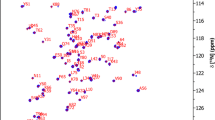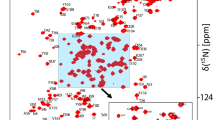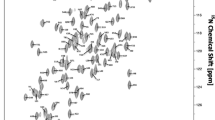Abstract
Staphylococcus aureus is a ubiquitous and persistent pathogen of humans and livestock. The bacterium disrupts the host’s innate immune system’s ability to recognize and clear bacteria with optimal efficiency by expressing a wide variety of virulence proteins. Two single domain protein homologs (EapH1, EapH2) of the extracellular adherence protein (Eap) have been reported. Eap is a multidomain protein that participates in various protein–protein interactions that inhibit the innate immune response, including both the complement and Neutrophil Serine Proteases (NSPs). EapH1 and EapH2 are also inhibitors of NSPs (Stapels et al., Proc Natl Acad Sci 111:13187–13192, 2014), but lack the ability to inhibit the classical, and lectin pathways of the complement activation system (Woehl et al., J Immunol 193:6161–6171, 2014). We continue the characterization of Eap domains, here with the experiments on EapH2, we acquired a series of 2D and 3D NMR spectra of EapH2 in solution. We completed 99% of expected non-proline backbone 1H, 15N, and 13C resonance assignments of EapH2 and predicted secondary structure via the TALOS-N server. The assignment data have been deposited in the BMRB data bank under Accession Number 27540.
Similar content being viewed by others
Biological context
Staphylococcus aureus is a ubiquitous and persistent pathogen of humans and livestock. The bacterium causes numerous infections of varying severity, including skin abscesses, endocarditis, and bacteremia, and receives particular attention due to increasing reports of antibiotic resistant strains. (Archer 1998; Lowy 1998; CDC 2011). Numerous studies have shown S. aureus secretes an array of virulence proteins whose activities block the central events required for bacterial opsonization by complement components and subsequent phagocytosis by neutrophils (Garcia et al. 2016; Kim et al. 2012; Lambris et al. 2008; Spaan et al. 2013). Furthermore, novel classes of S. aureus secreted proteins, such as the extracellular adherence protein (Eap) family (Stapels et al. 2014) and Staphylococcal Peroxidase Inhibitor (SPIN) proteins (de Jong et al. 2017) have recently been identified as nanomolar-affinity inhibitors of NSPs and myeloperoxidase (MPO), respectively.
The multi-domain Eap protein has a mass of 50–70 kDa depending on the number of ~ 100 residue repeating domains found in its various isoforms (Geisbrecht et al. 2005). Eap contributes to the overall virulence of S. aureus by blocking both the classical and lectin complement pathways (Woehl et al. 2014) and neutrophil serine proteases (NSPs) (Stapels et al. 2014). Two single domain protein homologs (EapH1, EapH2) of Eap have been also identified as inhibitors of NSPs (Stapels et al. 2014), but lack the ability to inhibit the classical, and lectin pathways of the complement activation system (Woehl et al. 2014). Recent work on Eap domains 3 and 4 reported their interaction with C4b and their ability to inhibit classical and lecitin pathways (Woehl et al. 2014, 2017). While the individual domains bound C4b with KD ~ 40 µM, the construct containing both domains, Eap34, bound C4b with KD = 525 nM. The binding affinity is even higher for Eap, KD = 185 nM. Crystal structures of the second domain of Eap (Eap2), along with two homologs EapH1 and EapH2, revealed that the individual domains are characterized by a β-grasp type fold (Geisbrecht et al. 2005). Finding a structural basis for the difference in the inhibitory capabilities between Eap domains and EapH proteins becomes a relevant question.
Here we report the secondary structural features of EapH2 in the free form in solution. After assigning the backbone 1H, 15N, 13Cα,13Cβ, and 13C′ resonances of EapH2, we predicted the secondary structure using the TALOS-N server along with the observed chemical shifts. These backbone assignments are the starting point for titrations with NSPs to identify the interaction site on EapH2 and other related Eap domains.
Methods and experiments
Protein expression and purification
EapH2 was overexpressed following methods established at our lab and reported earlier (Geisbrecht et al. 2006; Herrera et al. 2018). A DNA fragment encoding the protein sequence was subcloned into the Sal1 and Not1 sites of the prokaryotic expression vector pT7HMT. This vector encodes an N-terminal affinity His-tag that is used for Ni-affinity chromatography purification of the protein, but which can be removed by digestion with tobacco etch virus (TEV) protease. The EapH2 protein resulting after cleavage retains an additional “Gly-Ser-Thr” sequence at the N-terminus. The plasmid containing this DNA fragment was further verified by sequencing and transformed into Escherichia coli BL21(DE3) cells.
Both uniformly 15N and 13C/15N double-labeled EapH2 proteins were overexpressed in minimal medium (M9) enriched with 15NH4Cl (1 g/l) and 13C-glucose (1 g/l) as described in the protocol by Woehl et al. (2016). The purified protein yield from 1 l of E. coli culture was in the range of 5–10 mg for both 15N and 13C/15N double-labeled EapH2.
The samples for NMR experiments contained 0. 5–0.8 mM uniformly 15N or 13C/15N double-labeled EapH2 protein in 50 mM sodium phosphate buffer (pH 6.5) containing 5% (v/v) D2O (used as a lock solvent). The purity and mass of the labelled protein was verified using mass spectrometry (Ultra Flex III TOF, Bruker Daltonics) prior to NMR data acquisition.
NMR spectroscopy
NMR spectra were acquired at 25 °C on a Bruker Avance III NMR spectrometer equipped with a 5 mm cryogenically cooled TCI probe operating at 800 MHz for 1H frequency. Backbone resonance assignments were achieved following standard procedure (Whitehead et al. 1997) using 2D 1H–15N HSQC and 3D HNCO, HN(CA)CO, HN(CO)CA, HNCA, CBCA(CO)NH and HNCACB spectra. Only12% points of Nyquist grid in the indirect dimension were sampled non-uniformly using Poisson-Gap sampling scheme. These non-uniformly sampled (NUS) spectra were reconstructed using hmsIST (Hyberts et al. 2012), processed using NMRPipe (Delaglio et al. 1995), and analyzed with CARA software (Keller 2004). The 1H chemical shift assignments were referenced by using 2,2-dimethy-2-silapentane-5-sulphonic acid (DSS) at 25 °C as a standard. The 13C and 15N chemical shift were referenced indirectly to DSS, using the absolute frequency ratios. The acquisition parameters for all the NMR experiments are mentioned in Table 1. All the triple resonance NMR experimental data were acquired using non-uniform sampling.
Results
Extent of assignments and data deposition
Signals well dispersed and with adequate intensity were detected in the acquired 2D 1H–15N HSQC spectrum of EapH2 (Fig. 1). Amino acid numbering is based upon the EapH2 sequence, with an extra “Gly-Ser-Thr” sequence at the N-terminus. A total of 99% of backbone 1H and 15N resonances of 113 non-proline residues, and 95% of 13Cα, 97% of CO, and 71% of the expected 13Cβ resonances have been unambiguously assigned based on a standard set of triple resonance spectra described above. The backbone amide residues that could not be assigned are G1 and K16. G1 lies in a loop region of the artificial N-terminus as a result of the subcloning procedure.
2D 1H-15N HSQC spectrum of 0.7 mM 13C/15N-labeled EapH2 recorded at 298 K, pH 6.5 on a Bruker 800 MHz Avance III spectrometer equipped with a TCI cryoprobe. Sequence specific assignments of backbone amide groups are indicated by single letter residue name and sequence number. An expended section of the central, overlapped region is shown. The unlabeled cross peaks correspond to a fragment product of the expression system and side chains 1H–15N
The secondary structure elements of EapH2 were predicted by the TALOS-N program (Shen and Bax 2013) using the resonance assignments of 13Cα, 13Cβ, and 13C′ (Fig. 2). This prediction is in agreement with the secondary structures observed in EapH1, EapH2, and Eap2, as determined by X-ray crystallography (Geisbrecht et al. 2005), and the structural characteristics described by NMR for Eap3 and Eap4 (Herrera et al. 2018; Woehl et al. 2016). The chemical shift assignments have been deposited in BioMagResBank (http://www.bmrb.wisc.edu) under the Accession Number 27540.
Secondary structure prediction for the EapH2 domain based on the TALOS-N program using obtained chemical shift values. β-strand probabilities are given by positive values, α-helices are given by negative values, and loop regions are given by values approximately from − 0.3 to 0.3. At the top the prediction is further illustrated with α-helices shown as cylinders and β-sheets shown as arrows
References
Archer GL (1998) Staphylococcus aureus: a well-armed pathogen. Clin Infect Dis 26:1179–1181
Centers for Disease Control and Prevention (2011) 2011 Progress towards implementation of: a public health action plan to combat antimicrobial resistance. Retrieved from http://www.cdc.gov/drugresistance/resources/
de Jong NWM, Ramyar KX, Guerra FE, Nijland R, Fevre C, Voyich JM, McCarthy AJ, Garcia BL, van Kessel KPM, van Strijp JAG, Geisbrecht BV, Haas PJA (2017) Immune evasion by a staphylococcal inhibitor of myeloperoxidase. Proc Natl Acad Sci USA 35:9439–9444
Delaglio F, Grzesiek S, Vuister GW, Zhu G, Pfeifer J, Bax A (1995) NMRPipe: a multidimensional spectral processing system based on UNIX pipes. J Biomol NMR 6:277–293
Garcia BL, Zwarthoff SA, Rooijakkers SHM, Geisbrecht BV (2016) Novel evasion mechanisms of the classical complement pathway. J Immunol 197:2051–2060
Geisbrecht BV, Hamaoka BY, Perman B, Zemla A, Leahy DJ (2005) The crystal structures of EAP domains from Staphylococcus aureus reveal an unexpected homology to bacterial superantigens. J Biol Chem 280:17243–17250
Geisbrecht BV, Bouyan S, Pop M (2006) An optimized system for expression and purification of secreted bacterial proteins. Protein Expr Purif 46:23–32
Herrera AI, Ploscariu NT, Geisbrecht BV, Prakash O (2018) 1H, 15N, and 13C resonance assignments of the third domain from the S. aureus innate immune evasion protein Eap. Biomol NMR Assign 12:175–178
Hyberts SG, Milbradt AG, Wagner AB, Arthanari H, Wagner G (2012) Application of iterative soft thresholding for fast reconstruction of NMR data non-uniformly sampled with multidimensional Poisson Gap scheduling. J Biomol NMR 52:315–327
Keller R (2004) The computer aided resonance assignment tutorial. ISBN 3-85600-112-3
Kim HK, Thammavongsa V, Schneewind O, Missiakas D (2012) Recurrent infections and immune evasion strategies of Staphylococcus aureus. Curr Opin Microbiol 15:92–99
Lambris JD, Ricklin D, Geisbrecht BV (2008) Complement evasion by human pathogens. Nat Rev Microbiol 6:132–142
Lowy FD (1998) Staphylococcus aureus infections. N Engl J Med 339:550–532
Shen Y, Bax A (2013) Protein backbone and sidechain torsion angles predicted from NMR chemical shifts using artificial neural networks. J Biomol NMR 56:227–241
Spaan AN, Surewaard BGJ, Nijland R, van Strijp JAG (2013) Neutrophils versus Staphylococcus aureus: a Biological Tug of War. Annu Rev Microbiol 67:629–650
Stapels DA, Ramyar KX, Bischoff M, von Köckritz-Blickwede M, Milder FJ, Ruyken M, Eisenbeis J, McWhorter WJ, Herrmann M, van Kessel KP, Geisbrecht BV, Rooijakkers SH (2014) Staphylococcus aureus secretes a unique class of neutrophil serine protease inhibitors. Proc Natl Acad Sci USA 111:13187–13192
Whitehead B, Craven CJ, Waltho JP (1997) Double and triple resonance NMR methods for protein assignment. In: Reid DG (eds) Protein NMR techniques. Methods in molecular biology, vol 60. Humana Press, Totowa
Woehl JL, Stapels DAC, Garcia BL, Ramyar KX, Keightley A, Ruyken M, Syriga M, Sfyroera G, Weber AB, Zolkiewski M, Ricklin D, Lambris JD, Rooijakkers SHM, Geisbrecht BV (2014) The extracellular adherence protein from Staphylococcus aureus inhibits the classical and lectin pathways of complement by blocking formation of the C3 pro-convertase. J Immunol 193:6161–6171
Woehl JL, Takahashi D, Herrera AI, Geisbrecht BV, Prakash O (2016) 1H, 15N, and 13C resonance assignments of Staphylococcus aureus extracellular adherence protein domain 4. Biomol NMR Assign 10:301–305
Woehl JL, Ramyar KX, Katz BB, Walker JK, Geisbrecht BV (2017) The structural basis for inhibition of the classical and lectin complement pathways by S. aureus extracellular adherence protein. Protein Sci 26:1595–1608
Acknowledgements
This research was funded by awards from the National Institutes of Health to B.V.G. (GM121511 and AI111203).
Author information
Authors and Affiliations
Corresponding author
Ethics declarations
Conflict of interest
The authors declare that they have no conflict of interest.
Additional information
Publisher’s Note
Springer Nature remains neutral with regard to jurisdictional claims in published maps and institutional affiliations.
Rights and permissions
About this article
Cite this article
Herrera, A.I., Dubey, A., Geisbrecht, B.V. et al. Backbone resonance assignments of innate immune evasion protein EapH2 from the S. aureus. Biomol NMR Assign 13, 219–222 (2019). https://doi.org/10.1007/s12104-019-09880-3
Received:
Accepted:
Published:
Issue Date:
DOI: https://doi.org/10.1007/s12104-019-09880-3






